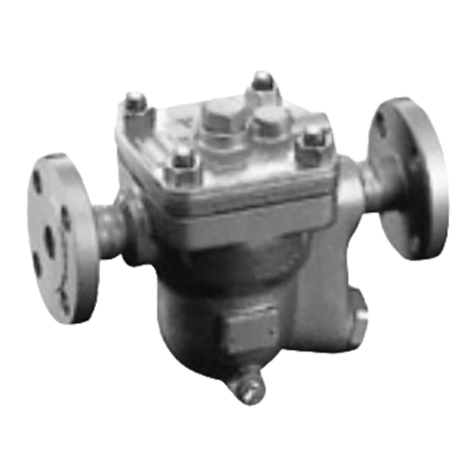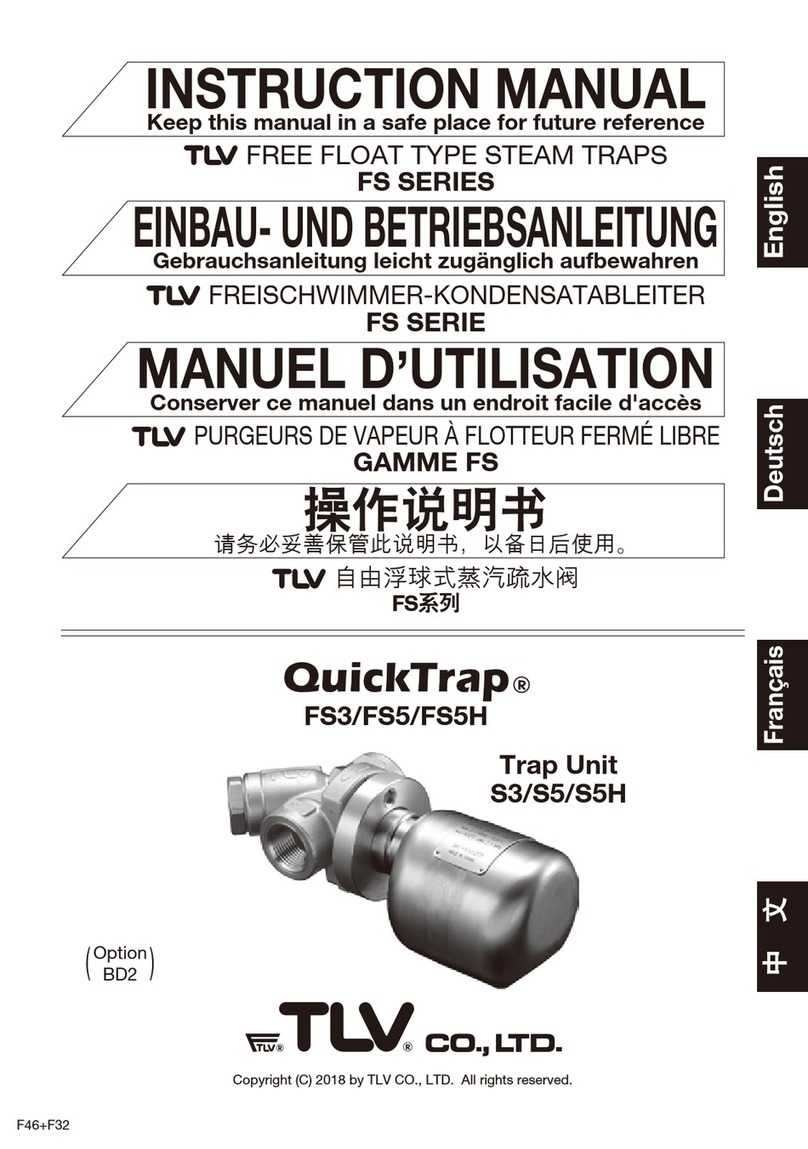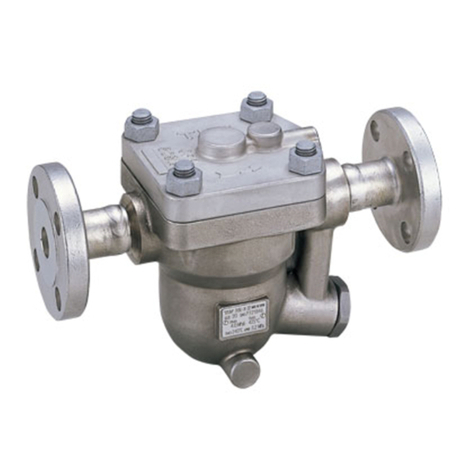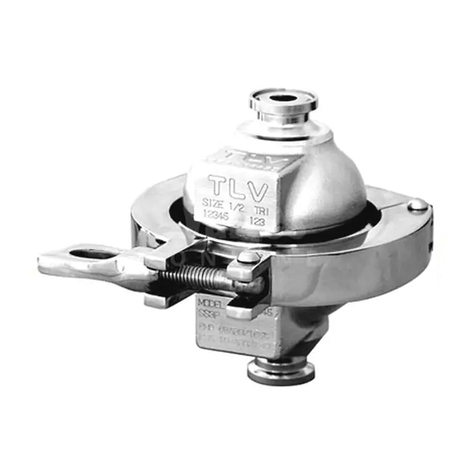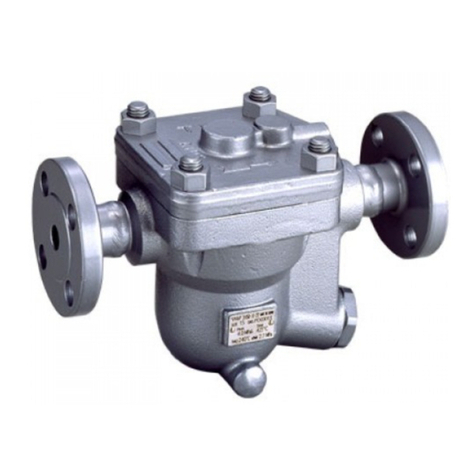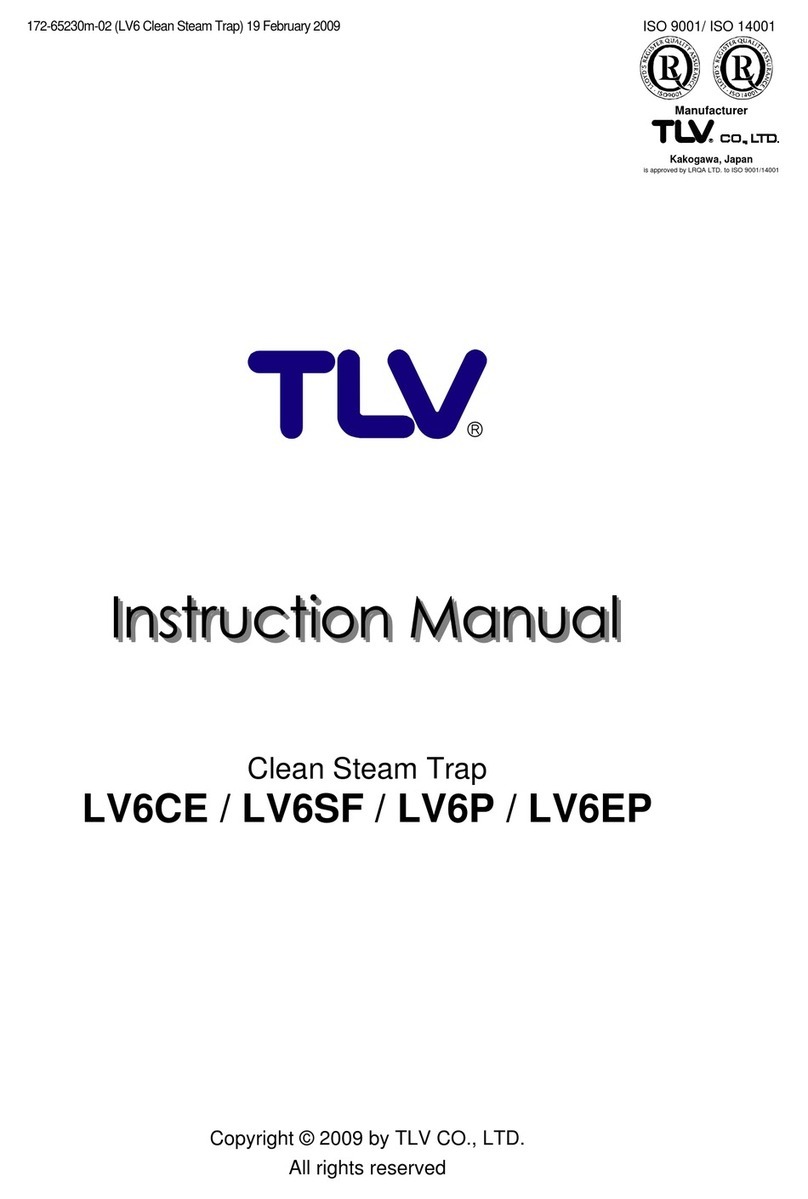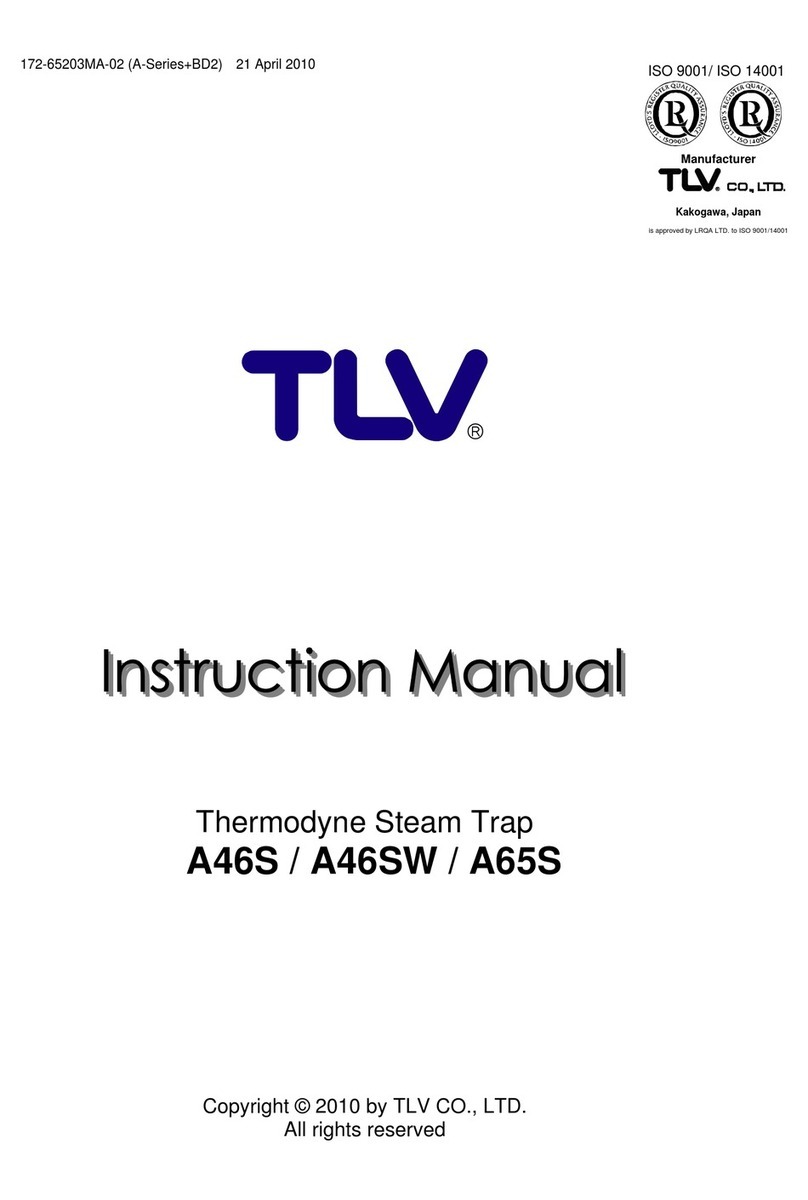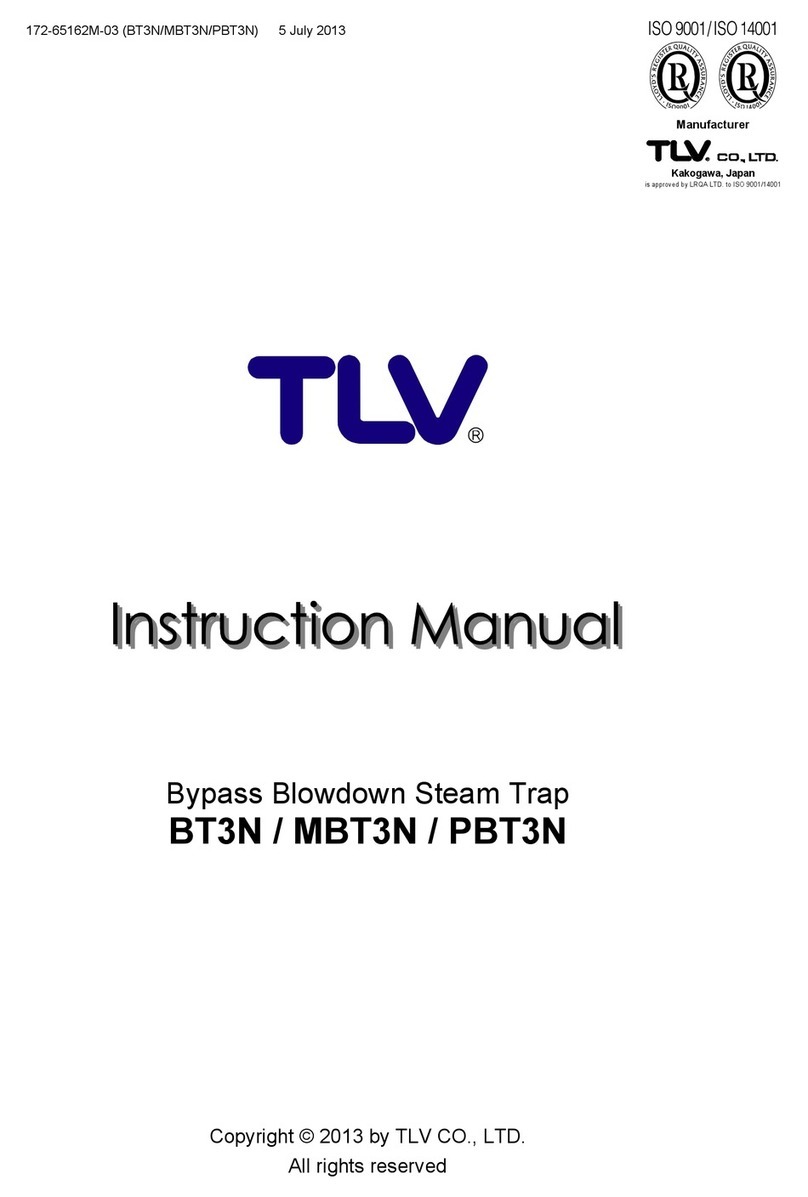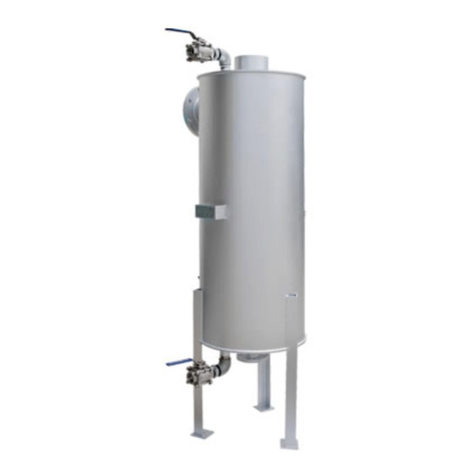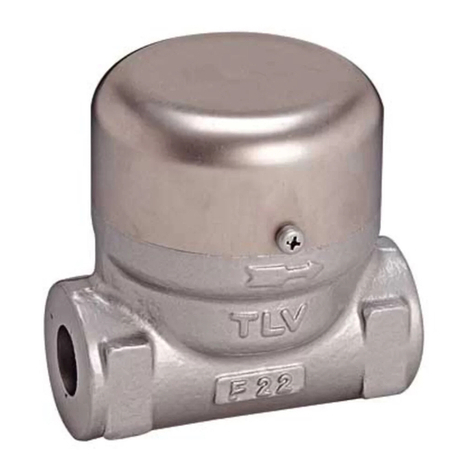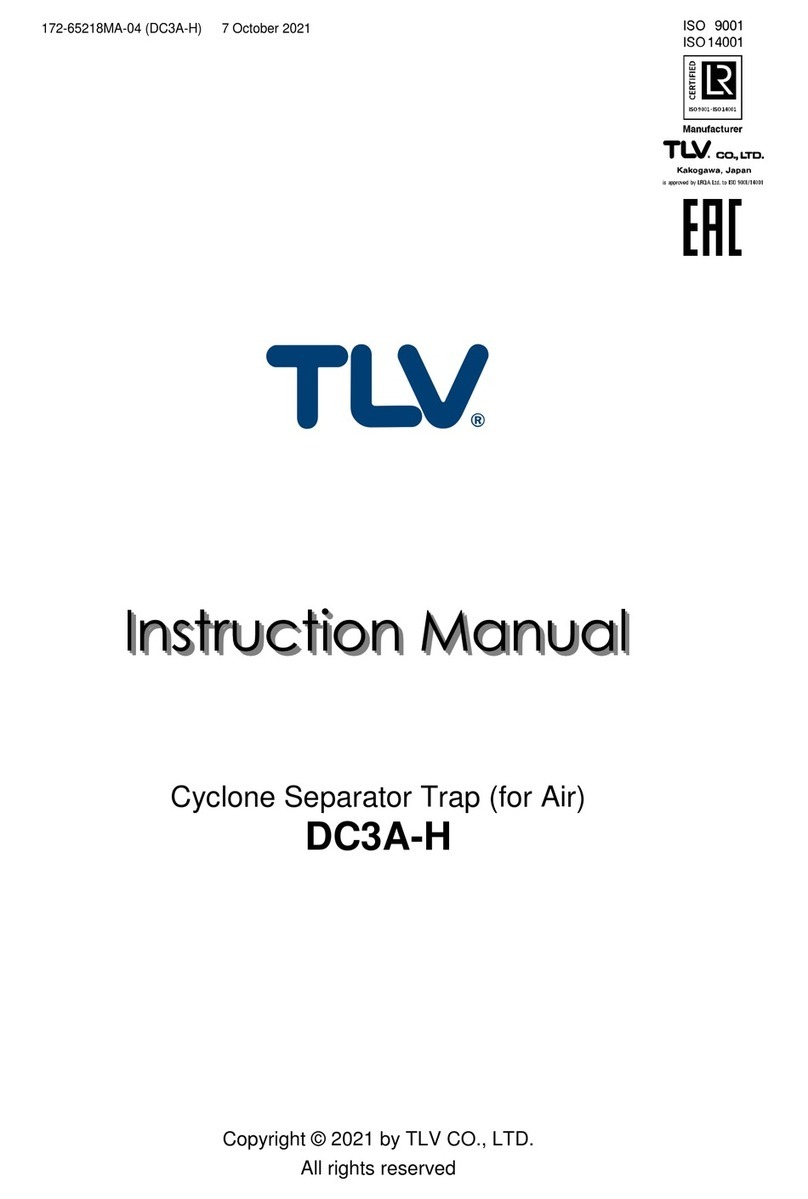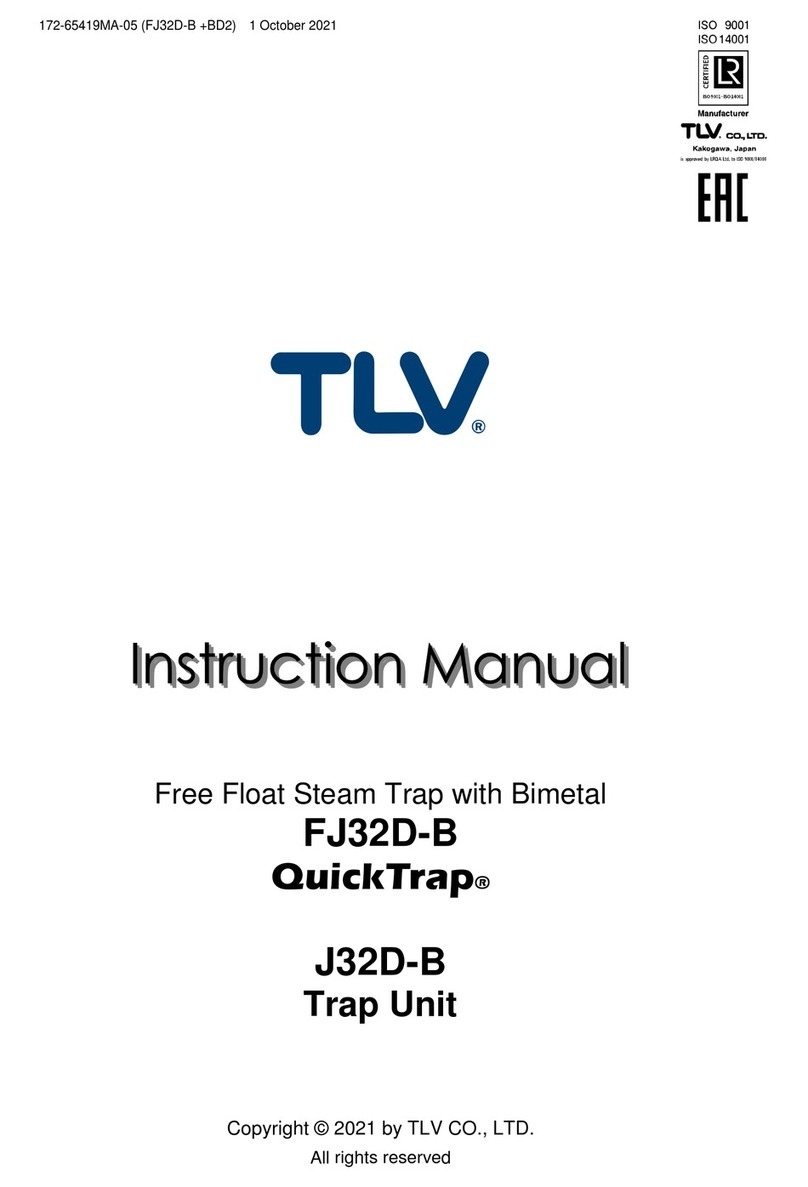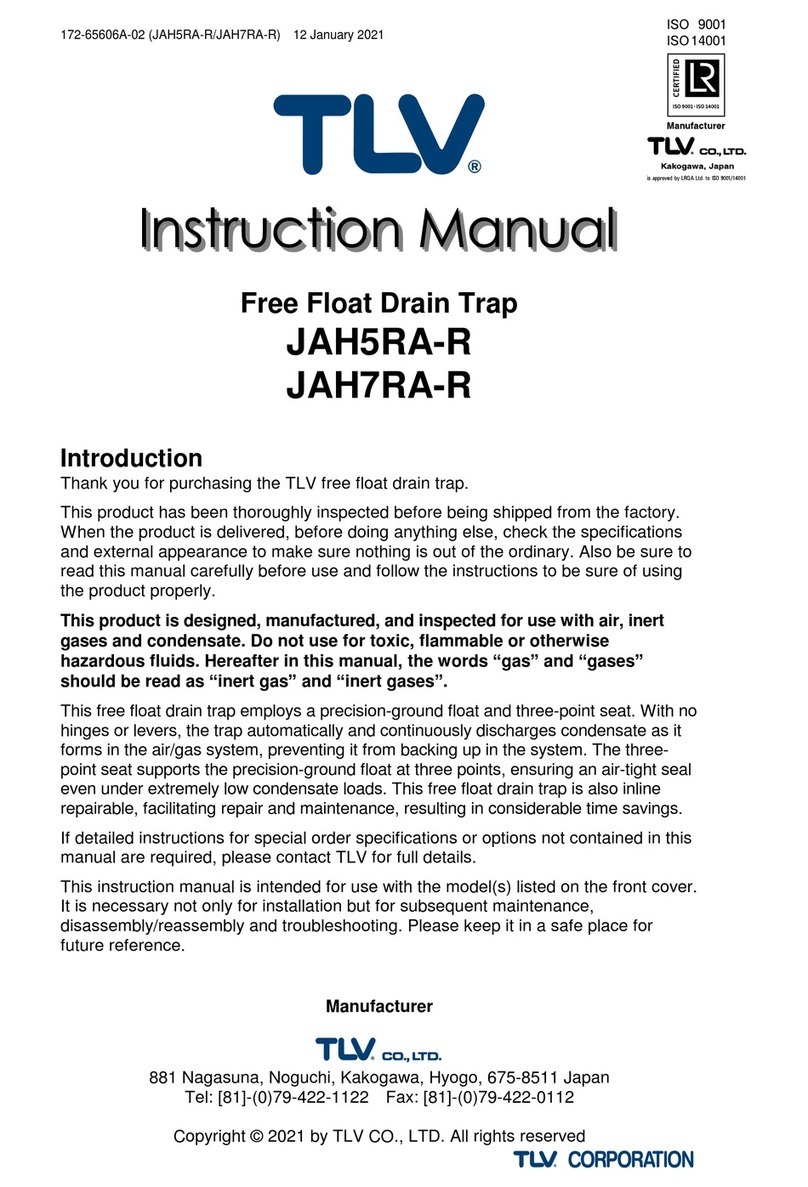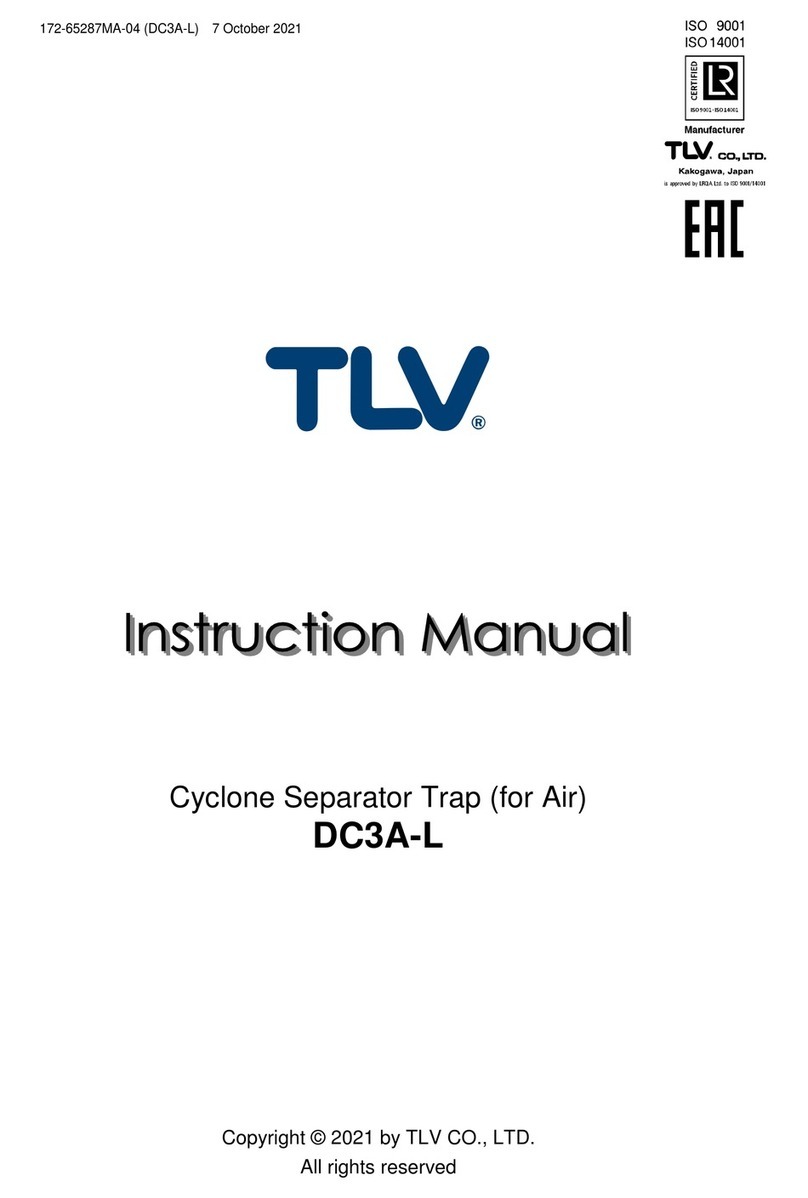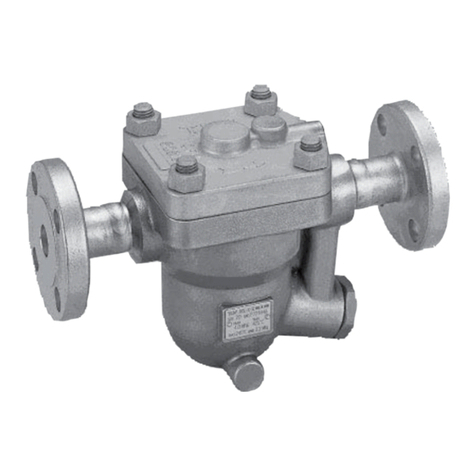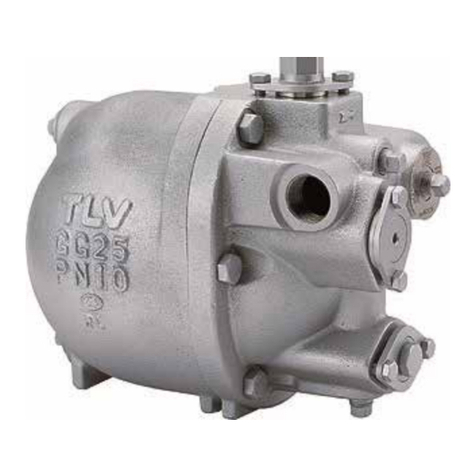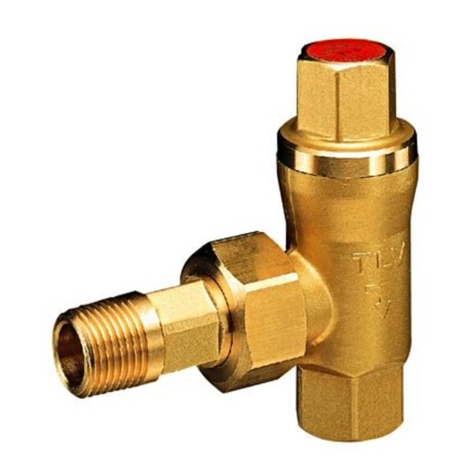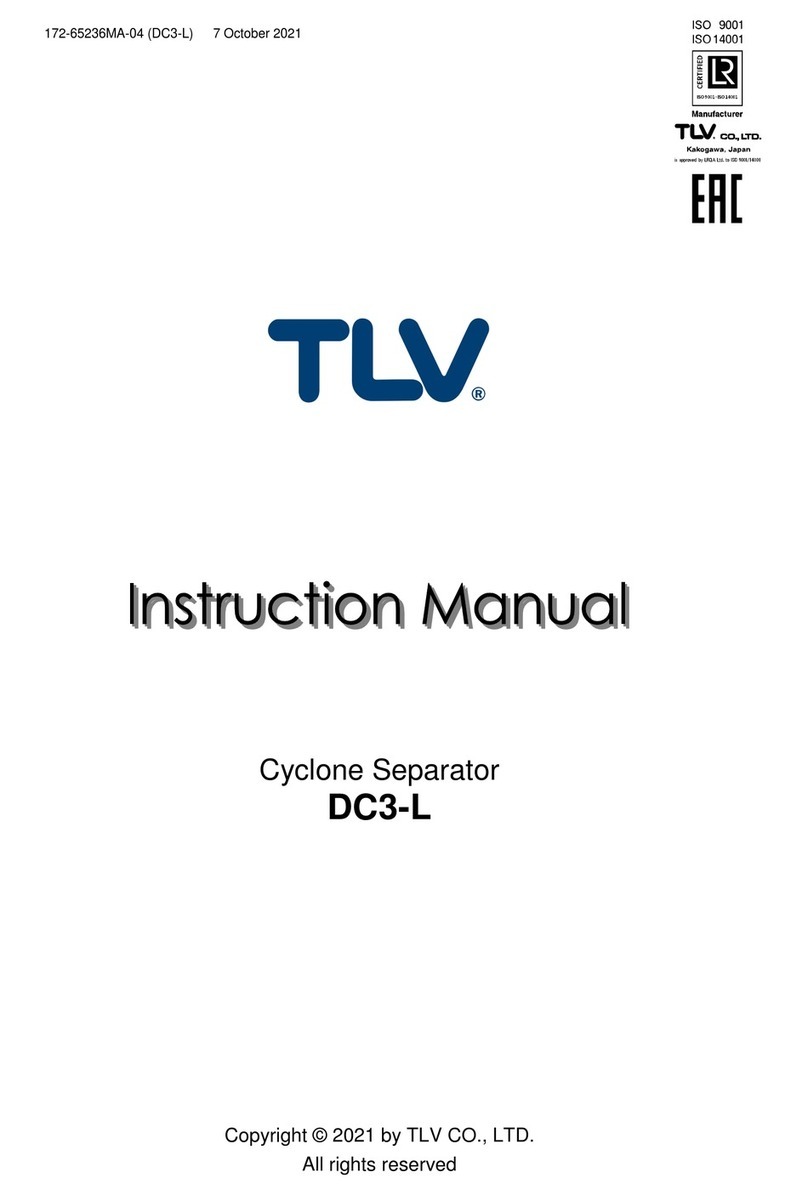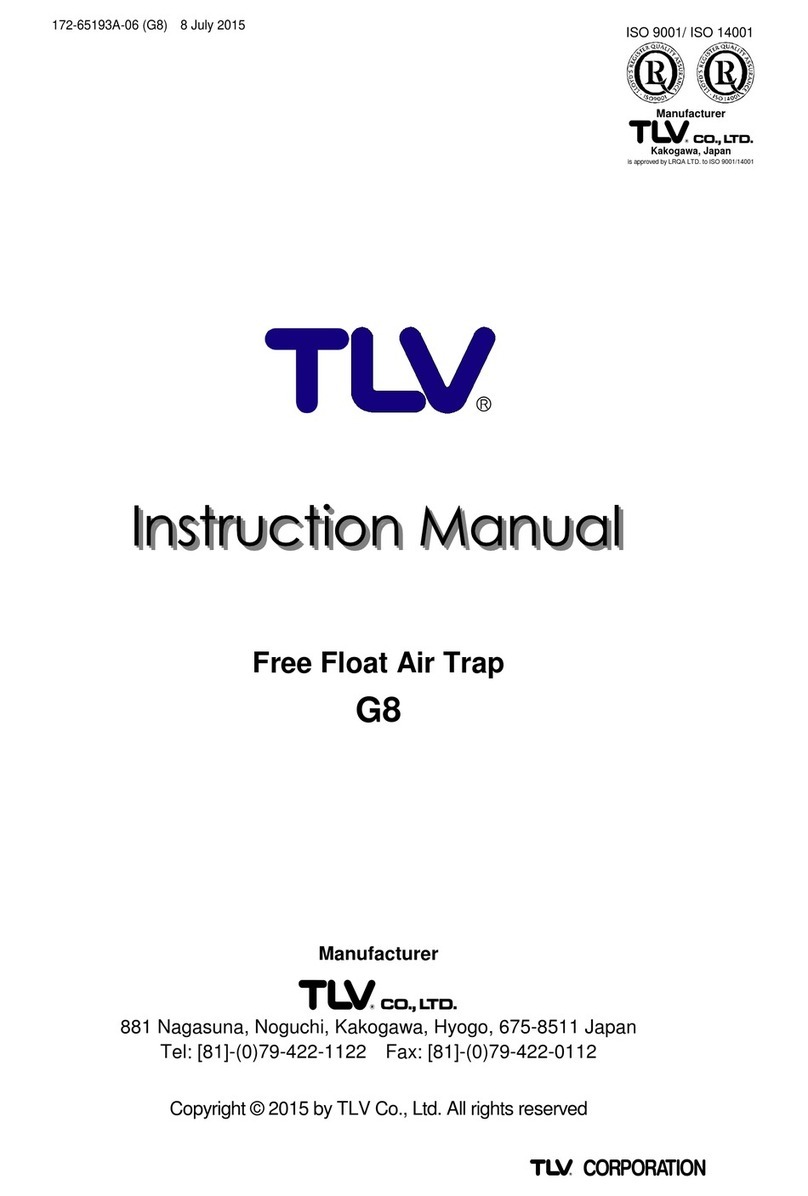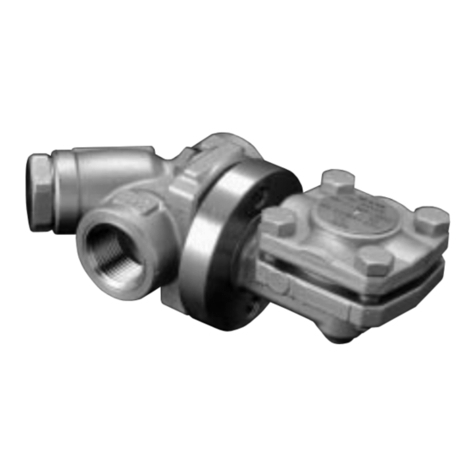TLV RGDS User manual

172-65608MA-03 (RGDS) 5 October 2021
Steam Desuperheating System
RGDS
Copyright © 2021 by TLV CO., LTD.
All rights reserved

172-65608MA-03 (RGDS) 5 Oct 2021
1
Contents
Contents............................................................................1
Introduction .......................................................................1
Safety Considerations.......................................................2
System Control..................................................................4
System Features...............................................................4
System Specifications.......................................................5
System Description ...........................................................6
Installation.........................................................................7
Pre-commissioning Verification.......................................10
Normal Operation and Shutdown Procedures ................11
Maintenance and Inspection...........................................13
Troubleshooting ..............................................................15
TLV EXPRESS LIMITED WARRANTY...........................19
Service ............................................................................21
Introduction
Thank you for purchasing the TLV steam desuperheating system RGDS.
This system has been thoroughly inspected before being shipped from the factory.
When the product is delivered, before doing anything else, check the specifications
and external appearance to make sure nothing is out of the ordinary. Also be sure to
read this manual carefully before use and follow the instructions to be sure of
installing and using the system properly by following the installation and operating
procedure.
After the completing the installation work, our technical personnel will explain the
commissioning and operation of this system. Please keep this manual,
commissioning report, specification and all documents related to this system for
further reference.
There are some cases on which this manual does not include instructions
concerning individual special specifications but instead refers to other manuals.
For further details please contact your closest TLV office.
This instruction manual is intended for use with the system listed on the front cover. It
is necessary not only for installation but for subsequent maintenance,
disassembly/reassembly and troubleshooting. Please keep it in a safe place for
future reference.

172-65608MA-03 (RGDS) 5 Oct 2021
2
Safety Considerations
Read this section carefully before use and be sure to follow the instructions.
Installation, inspection, maintenance, repairs, disassembly, adjustment and valve
opening/closing should be carried out only by trained maintenance personnel.
The precautions listed in this manual are designed to ensure safety and prevent
equipment damage and personal injury. For situations that may occur as a result of
erroneous handling, three different types of cautionary items are used to indicate
the degree of urgency and the scale of potential damage and danger: DANGER,
WARNING and CAUTION.
The three types of cautionary items above are very important for safety: be sure to
observe all of them as they relate to installation, use, maintenance, and repair.
Furthermore, TLV accepts no responsibility for any accidents or damage occurring
as a result of failure to observe these precautions.
Symbols
Indicates a DANGER, WARNING or CAUTION item.
Indicates an urgent situation which poses a threat of death or
serious injury
Indicates that there is a potential threat of death or serious injury
Indicates that there is a possibility of injury or equipment/product
damage
In the event of any abnormality, stop the system and utilities
supply (steam, water, air and electricity). Investigate the cause
of the abnormality and take countermeasures.
Forbid the supply of utilities to the system until the countermeasures
have been implemented.
Install properly and DO NOT use this system outside the
recommended operating pressure, temperature and other
specification ranges.
Improper use may result in such hazards as damage to the system
or malfunctions that may lead to serious accidents. Local
regulations may restrict the use of this system to below the
conditions quoted.
Use hoisting equipment for heavy objects (weighing
approximately 20 kg (44 lb) or more).
Failure to do so may result in back strain or other injury if the object
should fall.
Take measures to prevent people from coming into direct
contact with system outlets.
Failure to do so may result in burns or other injury from the
discharge of fluids.
Continued on the next page
DANGER
WARNING
CAUTION
WARNING
CAUTION

172-65608MA-03 (RGDS) 5 Oct 2021
3
When disassembling or removing the system, wait until the
internal pressure equals atmospheric pressure and the surface
of the system has cooled to room temperature.
Disassembling or removing the system when it is hot or under
pressure may lead to discharge of fluids, causing burns, other
injuries or damage.
Be sure to use only the recommended components when
repairing the system, and NEVER attempt to modify the system
in any way.
Failure to observe these precautions may result in damage to the
system and burns or other injury due to malfunction or the discharge
of fluids.
Do not use excessive force when connecting threaded pipes to
the system.
Over-tightening may cause breakage leading to fluid discharge,
which may cause burns or other injury.
Use only under conditions in which no water hammer will
occur.
The impactof water hammer maydamage the system, leadingtofluid
discharge, which may cause burns or other injury.
Make sure the power supply is OFF before carrying out work
on the wiring or inspections involving disassembly.
If such work is carried out with the power on, there is a danger that
components may malfunction or electric shock may occur, leading
to injury or other accidents.
Make sure that installation work requiring a special license is
carried out by qualified personnel.
Improper work may cause falls, dropped items, overheating and
electrical leaks, leading to injury, burns, fires, damage and other
accidents.
When using this system, NEVER stand close to, or leave tools
anywhere near moving parts, such as the shaft.
Contact with moving parts or objects becoming caught in moving
parts could lead to injury, damage or other accidents.
This system is composed of steam devices and piping.
Insulate the system properly to prevent burns and heat loss.
After all piping work has been performed according to the
system flow diagram, check that all connections are tightened,
all gaskets have been installed and for unsecure installations.
Improper piping work may lead to discharge of fluids, causing burns,
other injuries or damage.
Do NOT touch terminals when power is on.
This may lead to system breakages, erroneous operation,
electrical shock or fires.
CAUTION

172-65608MA-03 (RGDS) 5 Oct 2021
4
System Control
Use only under conditions in which no water hammer will occur. The
impact of water hammer may damage the system, leading to fluid
discharge, which may cause burns or other injury.
CAUTION
The TLV desuperheating system consists of three main parts,
Pressure reducing section, used to regulate steam pressure to the desired
setting value by a pressure control loop, as a result the steam pressure
stabilizes, which leads to a stable steam temperature.
Desuperheating section, consists of temperature control valves and injector with
nozzles, used to inject the cooling water in to the steam flow in order to reduce
the temperature of the steam. Feed control valves actuated though a
temperature control loop regulate the water volume injected for temperature
reduction.
Water mixing and separation section, consist of static mixer and condensate
separator, in order to desuperheat (reduce the temperature) from the steam with
the cooling water, by passing the flow through (2) static mixers connected in
series and later on through a cyclone separator to remove the excess water that
could exist.
System Features
The following are some features of the desuperheating system (RGDS) from TLV.
Stable and steady steam pressure supply
The spray nozzle used for water injection has a very fine tip in order to ensure
the spray absorbs the most heat in a shorter distance. Furthermore the heat
absorption effect is improved by forcibly mixing the flow with a static mixer.
In the unlikely event that any excess water is injected, it is forcibly removed by
condensate separators, so this excessive water will not flow into the downstream
of the system. As a result, the prevention of water hammer and stable heating
are achieved.

172-65608MA-03 (RGDS) 5 Oct 2021
5
System Specifications
Install properly and DO NOT use this system outside the recommended
operating pressure, temperature and other specification ranges.
Improper use may result in such hazards as damage to the system or
malfunctions which may lead to serious accidents. Local regulations
may restrict the use of this system to below the conditions quoted.
CAUTION
Item
Property
RGDS (Standard
Specification)
Ex-proof
Specification
Pressure
Reducing
Section
Steam Control
Valve
Model
CV101)
(Non Ex-proof)
CV101)
(Exd II BT5)
Size/Connection
Depends on specifications
Pressure
Sensor
(With Siphon)
Model
MBS33M1)
(Non Ex-proof)
KD431)
(Exd II BT4)
Size/Connection
R 3/8
R 1/2
Desuperheating
Section
Temperature
Control Valve
Model
CV101)
(Non Ex-proof)
CV101)
(Exd II BT5)
Size/Connection
Depends on specifications
Temperature
Sensor
Model
TR1-35S1)
R1G1) (d2G4)
Connection
R 3/8
R 1/2
Strainer
Model
Y31)
Size/Connection
Depends on specifications
Check Valve
Model
CKF3M1)
Connection
Flangeless (wafer) type
Size depends on specifications
Water Mixing
and Separation
Section
Water
Injector,
Static Mixer
Size/Connection
50 –200 mm (2 –8 in): JIS 10K,
20K, 30K, ASME/JPI Class 150, 300
Condensate
Separator
Model
DC3
Size
50 –150 mm (2 –6 in)
(For 200 mm (8 in) water
injector/static mixer, 150 mm (6 in)
separators installed in parallel)
Steam Trap
Model
JS-X series, JH series
Size/Connection
Depends on specifications
Pump Section2)
Pump
Model
CRN1)
(Non Ex-proof)
CRN1)
(eG3, d2G4)
Size/Connection
Depends on specifications
Control Panel
Power rating
200 V
Special order
Installation
Location
Indoor
Outdoor
Installation Type
Wall-
mounted
Stand-
alone
Pressure Range
0 to 1.6 MPaG (0 to 250 psig)
Minimum Set Temperature
5 C (10 F) above saturated steam temperature
(Size 200 mm (8 in): 10 C (20 F) above saturated
steam temp.)
Steam Supply Temp. Stability
Within 1 C (1.8 F)3)
Steam Velocity
5 to 50 m/s (20 to 160 ft/s)
Steam Discharge
200 to 30,000 kg/h (450 to 66,000 lb/h)
1) Standard products when the components are supplied by TLV. The model type may differ
depends on the installation environment.
2) This device is required when the pressure of the desuperheating water supplied to the
system is insufficient.
3) This value depends on the status of the process as well as the PID setting and is only to be
used as a reference.
For details regarding components, refer to the individual specification data sheets (SDS).

172-65608MA-03 (RGDS) 5 Oct 2021
6
System Description
Install properly and DO NOT use this system outside the recommended
operating pressure, temperature and other specification ranges.
Improper use may result in such hazards as damage to the system or
malfunctions which may lead to serious accidents. Local regulations
may restrict the use of this system to below the conditions quoted.
CAUTION
The TLV standard desuperheating system (RGDS) consist of three sections:
Pressure reducing section, desuperheating section and water mixing and separation
section.
Note: a pump section is required when the desuperheating water pressure is
insufficient.
Section
Component
Description
Pressure reducing
section
A
Pressure control valve
The pressure control valve reduces
the steam pressure as required.
B
Pressure sensor
Desuperheating
section
C
Temperature control
valve
The temperature control valve
reduces the steam temperature as
required.
The strainer prevents clogging of the
water injector’s internal nozzle by dirt,
rust and scale.
The check valve reduces the risk of
water hammer due to steam flowing
into the desuperheating water line.
D
Temperature sensor
E
Strainer
F
Check valve
Water mixing and
separation section
G
Water injector
Injects water and mixes it with steam
for desuperheating. Discharges
excess desuperheating water via the
separator.
The steam trap discharges
condensate from the separator and
excess desuperheating water.
H
Static mixer
I
Condensate separator
J
Steam trap
(F)
Desuperheating Section
Water Mixing & Separation Section
Pump Section
Pressure Reducing Section
Pit
Max. 30 m (98 ft)
(B) (D)
(A)
(K)
(I)
(H)
(G)
(C)
(E)
Desuperheating
water
Minimum
flow
Superheated
steam Desuperheated
steam
Condensate
recovery
Required length:
1.5 m (5 ft)
In case of two-stage pressure reduction, make
sure to keep at least 1 m (3 ft) between the first
and second pressure reducing valve.
Safety
valve
(J)
Control
box
1/100 to 1/200
Required straight piping
length: See “Minimum
required straight piping
length by nominal
diameter” on page 8.

172-65608MA-03 (RGDS) 5 Oct 2021
7
Installation
Install properly and DO NOT use this system outside the recommended
operating pressure, temperature and other specification ranges.
Improper use may result in such hazards as damage to the system or
malfunctions which may lead to serious accidents. Local regulations
may restrict the use of this system to below the conditions quoted.
CAUTION
Use hoisting equipment for heavy objects (weighing approximately
20 kg (44 lb) or more). Failure to do so may result in back strain or other
injury if the object should fall.
CAUTION
Take measures to prevent people from coming into direct contact with
product outlets. Failure to do so may result in burns or other injury from
the discharge of fluids.
CAUTION
Do not use excessive force when connecting threaded pipes to the
system. Over-tightening may cause breakage leading to fluid
discharge, which may cause burns or other injury.
CAUTION
Make sure that installation work requiring a special license is carried out
by qualified personnel. Improper work may cause falls, dropped items,
overheating and electrical leaks, leading to injury, burns, fires, damage
and other accidents.
CAUTION
After all piping work has been performed according to the system flow
diagram, check that all connections are tightened, all gaskets have
been installed and for unsecure installations. Improper piping work may
lead to discharge of fluids, causing burns, other injuries or damage.
CAUTION
This system is composed of steam devices and piping.
Insulate the system properly to prevent burns and heat loss.
CAUTION
Pressure Reducing Section
Ensure the distance between the pressure
reducing valve and the pressure control valve (A)
is 30 d or more when reducing supply steam on the
primary side of the control valve (A).
Desuperheating Section
1. The piping distance from the temperature
control valve (C) outlet to the injector (G)
nozzle should be as short as possible in order
to reduce pressure losses.
2. Install the temperature sensors (D) so that the
sensor portion is inserted into the piping.
Sensor Portion
Piping
Pressure
Reducing Valve Pressure Control
Valve (A)
30 d or more
d = Pipe diameter
Temp. Control
Valve (C)
Water Injector (G)
30 m (98 ft)
or less

172-65608MA-03 (RGDS) 5 Oct 2021
8
Water Mixing and Separation Section
1. Make sure the piping between the injector (G) and the temperature sensors (D) is
straight and horizontal. Do not install other devices such as check valves and
strainers that could cause a pressure drop.
2. Ensure the piping between the injector (G) and the condensate separator (I) is at
a slight decline (between 1:100 and 1:200) and is of the required straight piping
distance.
Minimum required straight piping length by nominal diameter
Pipe
size/DN
mm
50
65
80
100
125
150
200
(in)
(2)
(21/2)
(3)
(4)
(5)
(6)
(8)
Length
m
(ft)
4.5
(15)
5.5
(9)
6.5
(22)
7.5
(25)
10
(33)
3. The injector (G) and static mixer (H) each have an installation direction.
Installation in the wrong direction will prevent the equipment from functioning as a
desuperheater.
a) There is a circular engraving on top of
the injector body (G) (see right). Make
sure this engraving is on the
downstream side of the injector when
installing the desuperheating water
piping.
b) The static mixer (H) is shipped as two
separate pipe-shaped products.
Each static mixer has a flow direction
indicated on the flange (L = Left, R =
Right). Make sure the second mixer starts
with the same direction as the first mixer, i.e. “LR-LR”and “RL-RL”.
Note: “L”and “R”do not denote upstream and downstream.
In addition, make sure the static mixer flange faces meet so that the internal
mixer partitions meet at right angles to each other at the flange face.
There is no restriction on the direction the mixer partitions face in the end of
the flanges on the upstream and downstream sides.
4. Ensure the steam trap (J) on the condensate outlet of the injector (I) is installed in
a location where inspections and maintenance can be performed.
Allowable inclination:
1:100 to 1:200
Required straight
piping distance
Condensate
Separator (I)
Static Mixer (H)
Water Injector (G)
Upstream Downstream
Engraving
Mixer partitions

172-65608MA-03 (RGDS) 5 Oct 2021
9
Other
Carefully consider the following items if installing a pump.
1. Install piping supports on the suction side and discharge side of the pump (K) and
make sure there is no load on the pump body.
2. Install flexible tubing on both the suction side and discharge side of the pump (K),
to prevent vibrations from the pump from transmitting through the piping.
Make sure to use vibration absorbing type flexible tubing for use with pumps.
3. Install a strainer to prevent foreign matter from entering the suction side of the
pump (K).
4. Set a minimum flow line for the pump (K) and make sure not to operate the pump
under shut-off conditions.

172-65608MA-03 (RGDS) 5 Oct 2021
10
Pre-commissioning Verification
Install properly and DO NOT use this system outside the recommended
operating pressure, temperature and other specification ranges.
Improper use may result in such hazards as damage to the system or
malfunctions which may lead to serious accidents. Local regulations
may restrict the use of this system to below the conditions quoted.
CAUTION
After all piping work has been performed according to the system flow
diagram, check that all connections are tightened, all gaskets have
been installed and for unsecure installations. Improper piping work may
lead to discharge of fluids, causing burns, other injuries or damage.
CAUTION
Checking the System
1. Preparation
1.1 Items to prepare
System equipment list
Flow diagram
Product specifications
Control box diagrams, terminal connection diagrams, sequence diagrams
Applicable equipment documents (drawings, specifications etc.)
Instruction manuals for each products
1.2 Items to verify
Verify whether commissioning can be performed.
Installation progress (verify whether piping and wiring installation is
complete)
Utilities (verify whether steam, water and electricity are supplied)
Personnel from user’s side to witness the commissioning (ensure at least
one person is present)
Process for maintenance work in the event of a problem, or preparations
for such work
Preparations for the load (steam venting) for steam control adjustment
Note: Commissioning should be conducted with TLV personnel present.

172-65608MA-03 (RGDS) 5 Oct 2021
11
Normal Operation and Shutdown Procedures
Operating Procedures: Pressure Reducing Section
2. Pressure reducing section
2.1 Preparation
1. Supply electricity and air to the system.
2. Turn on the power for the control box.
3. Check whether the pressure sensor values are normal.
4. Check whether the valves before and after the system are open.
2.2 Verification for manual operation
1. Open the pressure control valve manually to 10%.*
(Verify that steam has started to flow.)
2. Wait 5 minutes for the hot air in the steam piping to be discharged.
3. Slowly open the pressure control valve (at a rate of approximately 10%
per 2 minutes), until the indicated pressure is approximately 0.2 MPaG
less than the target value.
* If superheated steam cannot be supplied to the steam-using equipment side,
perform the operating procedures for the desuperheating section in parallel with the
operating procedures for the pressure reducing section.
2.3 Verification for automatic operation
1. Verify that the pressure has reached approximately 0.2 MPaG less than
the target value and switch to automatic operation.
2. Verify that the steam pressure is stable at the target value.
Operating Procedures: Desuperheating Section
3. Pressure reducing section
3.1 Preparation
1. Supply electricity, air and water to the system.
2. Turn on the power for the control box.*
3. Check whether the temperature sensor values are normal.
4. If a pump is installed, start operating the pump.
5. Check whether the valves before and after the system are open.
3.2 Verification for manual operation
1. Open the temperature control valve manually to 10%.*
(Verify that steam has started to flow.)
2. Slowly open the temperature control valve (at a rate of approximately 10%
per 2 minutes), until the indicated temperature is approximately 10 °C less
than the target value.
3.2 Verification for automatic operation
1. Verify that the temperature has reached approximately 10 °C less than the
target value and switch to automatic operation.
2. Verify that the steam temperature is stable at the target value.
Check visually that the amount of condensate discharged by the separator is
normal.
* Unnecessary if sharing the same control box as the pressure reducing section.

172-65608MA-03 (RGDS) 5 Oct 2021
12
Shutdown Procedures: Pressure Reducing Section
1. Slowly close the pressure reducing valve (approximately 10% per 2 minutes).
2. Verify that the pressure reducing valve is fully closed, and then close the manual
valve on the primary side of the pressure reducing valve.
3. Turn off the power for the control box.*
* Unnecessary if sharing the same control box as the pressure reducing section.
Shutdown Procedures: Desuperheating Section
1. Verify that the pressure reducing section has stopped. If a pump is installed, stop
the pump.
2. Close the temperature control valve fully.
3. Verify that the temperature control valve is fully closed, and then close the
manual valve on the primary side of the temperature reducing valve.
4. Stop the electricity supply for the control box and close the valves for the air
supply to the control valve instruments.

172-65608MA-03 (RGDS) 5 Oct 2021
13
Maintenance and Inspection
When disassembling or removing the system, wait until the internal
pressure equals atmospheric pressure and the surface of the system has
cooled to room temperature. Disassembling or removing the system
when it is hot or under pressure may lead to discharge of fluids, causing
burns, other injuries or damage.
CAUTION
Be sure to use only the recommended components when repairing the
system, and NEVER attempt to modify the product in any way. Failure to
observe these precautions may result in damage to the system or burns
or other injury due to malfunction or the discharge of fluids.
CAUTION
Make sure the power supply is OFF before carrying out work on the
wiring or inspections involving disassembly. If such work is carried out
with the power on, there is a danger that components may malfunction
or electric shock may occur, leading to injury or other accidents.
CAUTION
Make sure that installation work requiring a special license is carried out
by qualified personnel. Improper work may cause falls, dropped items,
overheating and electrical leaks, leading to injury, burns, fires, damage
and other accidents.
CAUTION
When using this system, NEVER stand close to, or leave tools anywhere
near moving parts, such as the shaft. Contact with moving parts or
objects becoming caught in moving parts could lead to injury, damage
or other accidents.
CAUTION
Periodically inspect and check the following items as preventive maintenance.
For details regarding maintenance considerations, refer to the individual instruction
manual for each component.
Maintenance Checklist
To promote trouble-free operation of the system, inspections and maintenance of the
following items should be carried out periodically.
Injector pump
Daily inspection
Leakage from pump mechanical seal
Abnormal sounds from the pump or motor
Values indicated by the pressure/temp. gauges
Monthly inspection,
maintenance point
Pump suction pressure changes
Cracks in the tank and piping or water leakage
When there is a risk of freezing or the system will not be used for
a long time, water must be blown from the tank and pump interior
Valves
Daily inspection
Leakage from the valve body
Control valve air pressure and valve aperture
Annual inspection
Disassemble and clean the control valves
Other accessories
Daily inspection
Values indicated by the pressure/temp. gauges
Monthly inspection,
maintenance point
Disassemble and clean Y strainers, blow strainers with
condensate blow valves
Steam trap and condensate separator operation
Spray nozzle is not blocked

172-65608MA-03 (RGDS) 5 Oct 2021
14
Replacement Timing for Consumables
Refer to the following table as a guide for the timing to replace consumable parts.
Part
Replacement Timing
Pump
Mechanical seal
When liquid leakage is observed or after 8000 hours
operation
Shaft, bearings
Every 2 to 3 years
Gaskets
When liquid leakage is observed or when disassembling
Refer to individual instruction manuals for other maintenance and inspection procedures.

172-65608MA-03 (RGDS) 5 Oct 2021
15
Troubleshooting
In the event of any abnormality, stop the system and utilities supply
(steam, water, air and electricity). Investigate the cause of the
abnormality and take countermeasures. Prevent the supply of utilities to
the system until the countermeasures have been implemented.
WARNING
Use hoisting equipment for heavy objects (weighing approximately
20 kg (44 lb) or more). Failure to do so may result in back strain or other
injury if the object should fall.
CAUTION
Take measures to prevent people from coming into direct contact with
product outlets. Failure to do so may result in burns or other injury from
the discharge of fluids.
CAUTION
When disassembling or removing the system, wait until the internal
pressure equals atmospheric pressure and the surface of the product
has cooled to room temperature. Disassembling or removing the system
when it is hot or under pressure may lead to discharge of fluids, causing
burns, other injuries or damage.
CAUTION
Be sure to use only the recommended components when repairing the
system, and NEVER attempt to modify the product in any way. Failure to
observe these precautions may result in damage to the system or burns
or other injury due to malfunction or the discharge of fluids.
CAUTION
Make sure the power supply is OFF before carrying out work on the
wiring or inspections involving disassembly. If such work is carried out
with the power on, there is a danger that components may malfunction
or electric shock may occur, leading to injury or other accidents.
CAUTION
Make sure that installation work requiring a special license is carried out
by qualified personnel. Improper work may cause falls, dropped items,
overheating and electrical leaks, leading to injury, burns, fires, damage
and other accidents.
CAUTION
When using this system, NEVER stand close to, or leave tools anywhere
near moving parts, such as the shaft. Contact with moving parts or
objects becoming caught in moving parts could lead to injury, damage
or other accidents.
CAUTION
Do NOT touch terminals when power is on. This may lead to system
breakages, erroneous operation, electrical shock or fires.
CAUTION
When the system fails to operate properly, use the following table to locate the cause
and remedy.
Item
Cause
Diagnostic
Remedy
The pump
does not start
A current is not
applied to the
pump
The power is not turned on
Turn on the power
The wiring is disconnected or not
connected
Connect the wiring
The power is cut off
Apply current to the
pump
The non-fuse
breaker is
operating
There is a short in the sequence
Fix the control system
then reset the non-
fuse breaker
The pump
cannot be
activated
A thermal relay has tripped or the
wiring is disconnected
Disassemble and
clean the pump
If the motor is broken,
replace the motor
Reset the thermal
relay
Continued on the next page

172-65608MA-03 (RGDS) 5 Oct 2021
16
Item
Cause
Diagnostic
Remedy
The pump
suction
pressure
gauge
indicates the
actual suction
pressure
The pump is
running empty
Water is not flowing into the pump
Open the pump inlet
valve and discharge
air
The pump is
running
backwards
The operating direction is incorrect
Correct the wiring
The number of
rotations is too
low
Measure the number of rotations
with a tachometer
Correct the frequency
The lifting height
is lower
See the instruction manual for the
pump
Replace with a new
pump
Foreign matter is
clogging the
pump
Check if there is foreign matter in
the pump inlet
Clean the pump
The pressure
gauge on the
pump outlet is
broken
The pressure gauges on the pump
inlet and outlet show the same
pressure at shutdown
Replace with a new
pressure gauge
Steam or
desuperheating
water are not
supplied
The steam inlet
valve is still
closed
The inlet valve is closed
Open the inlet valve
The steam
pressure control
valve (CV) is still
closed; the
steam pressure
control valve
does not move
at all
Check the wiring to the control
valve; check the controller wire
connections; check the input signal
wiring for incorrect connections
Check the electrical
wiring diagram and
correct the wiring
Check that a signal of 4 –20 mA is
being received by the CV at the
connection terminals
Adjust the controller or
positioner or replace
with a new controller
or positioner
Check the secondary pressure of
the steam pressure control valve; if
the electrical wiring and signal are
normal, then the steam pressure
control valve is malfunctioning
Disassemble, inspect
or replace the steam
pressure control valve
Check if air is being supplied to the
steam pressure control valve (CV)
positioner
Supply air to the
positioner
Does not reach
desired steam
pressure
The PID set
values are
incorrect
Check the PID set values
Correct the PID set
values
The pressure
sensor is
malfunctioning
Check the pressure value reading
from the sensor and compare with
the pressure gauge, if the electrical
wiring and signal are normal, then
the pressure sensor is
malfunctioning
Replace with a new
pressure sensor
Component(s)
inside the
pressure control
valve positioner
are broken
Check for abnormal sounds from
the positioner
Replace with a new
positioner
(Investigate whether
the valve aperture
changes frequently or
the ambient
temperature is too
high)
Continued on the next page

172-65608MA-03 (RGDS) 5 Oct 2021
17
Item
Cause
Diagnostic
Remedy
Does not reach
desired steam
pressure
There is a
problem with the
input current of
the pressure
control valve
Check that a signal of 4 –20 mA is
being received from the pressure
sensor at the connection terminals
Adjust the controller or
replace with a new
controller
Supply steam
pressure is too
low
Check whether there is a correct
steam pressure
Supply steam at the
correct pressure
Temperature
does not go
down
Operation at a
temperature
outside the
operating
specifications
Check the specifications
Operate within the
range of the operating
specifications
There is
insufficient
desuperheating
water
The Y-strainer installed on the
desuperheating water line is
blocked
Clean the Y-strainer
The lifting height of the pump has
decreased
If the pump lifting
height has decreased,
replace with a new
pump
Check the aperture of the
temperature control valve
(Check whether the value on the
controller and the valve aperture
match)
Correct the air
pressure supplied to
the positioner
Repair any air
leakages between the
temperature control
valve actuator and
positioner
The PID set
values are
incorrect
Check the PID set values
Correct the PID set
values
The temperature
sensor is
malfunctioning
Check the temperature value
reading from the sensor and
compare with the temperature
gauge, if the electrical wiring and
signal are normal, then the
temperature sensor is
malfunctioning
Replace with a new
temperature sensor
Temperature is
below the set
value
The temperature
sensor is
malfunctioning
Check the temperature value
reading from the sensor and
compare with the temperature
gauge, if the electrical wiring and
signal are normal, then the
temperature sensor is
malfunctioning
Replace with a new
temperature sensor
The condensate
separator is
blocked
Condensate is not being
discharged, the surface
temperature of the separator is cold
Perform maintenance
on the separator or
replace with a new
separator
The temperature
sensor is
installed wrong
The probe section of the
temperature sensor is not in the
center of the piping
(The sensor is measuring the
temperature of the condensate on
the bottom of the piping)
Correct the installed
length of the
temperature sensor
Continued on the next page

172-65608MA-03 (RGDS) 5 Oct 2021
18
Item
Cause
Diagnostic
Remedy
Does not reach
desired steam
temperature
The PID set
values are
incorrect
Check the PID set values
Correct the PID set
values
The temperature
sensor is
malfunctioning
Check the temperature value
reading from the sensor and
compare with the temperature
gauge, if the electrical wiring and
signal are normal, then the
temperature sensor is
malfunctioning
Replace with a new
temperature sensor
Component(s)
inside the
pressure control
valve positioner
are broken
Check for abnormal sounds from
the positioner
Replace with a new
positioner
(Investigate whether
the valve aperture
changes frequently or
the ambient
temperature is too
high)
There is a
problem with the
input current of
the temperature
control valve
Check that a signal of 4 –20 mA is
being received by the CV at the
connection terminals
Adjust the controller or
replace with a new
controller
Desuperheating
water pressure
is too low
Check whether there is a correct
steam pressure
Supply steam at the
correct pressure

172-65608MA-03 (RGDS) 5 Oct 2021
19
TLV EXPRESS LIMITED WARRANTY
Subject to the limitations set forth below, TLV CO., LTD., a Japanese corporation
(“TLV”), warrants that products which are sold by it, TLV International Inc. (“TII”) or
one of its group companies excluding TLV Corporation (a corporation of the United
States of America), (hereinafter the “Products”) are designed and manufactured by
TLV, conform to the specifications published by TLV for the corresponding part
numbers (the “Specifications”) and are free from defective workmanship and
materials. The party from whom the Products were purchased shall be known
hereinafter as the “Seller”. With regard to products or components manufactured by
unrelated third parties (the “Components”), TLV provides no warranty other than the
warranty from the third party manufacturer(s), if any.
Exceptions to Warranty
This warranty does not cover defects or failures caused by:
1. improper shipping, installation, use, handling, etc., by persons other than TLV,
TII or TLV group company personnel, or service representatives authorized by
TLV; or
2. dirt, scale or rust, etc.; or
3. improper disassembly and reassembly, or inadequate inspection and
maintenance by persons other than TLV or TLV group company personnel, or
service representatives authorized by TLV; or
4. disasters or forces of nature or Acts of God; or
5. abuse, abnormal use, accidents or any other cause beyond the control of TLV,
TII or TLV group companies; or
6. improper storage, maintenance or repair; or
7. operation of the Products not in accordance with instructions issued with the
Products or with accepted industry practices; or
8. use for a purpose or in a manner for which the Products were not intended; or
9. use of the Products in a manner inconsistent with the Specifications; or
10. use of the Products with Hazardous Fluids (fluids other than steam, air, water,
nitrogen, carbon dioxide and inert gases (helium, neon, argon, krypton, xenon
and radon)); or
11. failure to follow the instructions contained in the TLV Instruction Manual for the
Product.
Duration of Warranty
This warranty is effective for a period of one (1) year after delivery of Products to the
first end user. Notwithstanding the foregoing, asserting a claim under this warranty
must be brought within three (3) years after the date of delivery to the initial buyer if
not sold initially to the first end user.
ANY IMPLIED WARRANTIES NOT NEGATED HEREBY WHICH MAY ARISE BY
OPERATION OF LAW, INCLUDING THE IMPLIED WARRANTIES OF MERCHANTABILITY
AND FITNESS FOR A PARTICULAR PURPOSE AND ANY EXPRESS WARRANTIES NOT
NEGATED HEREBY, ARE GIVEN SOLELY TO THE INITIAL BUYER AND ARE LIMITED IN
DURATION TO ONE (1) YEAR FROM THE DATE OF SHIPMENT BY THE SELLER.
Exclusive Remedy
THE EXCLUSIVE REMEDY UNDER THIS WARRANTY, UNDER ANY EXPRESS
WARRANTY OR UNDER ANY IMPLIED WARRANTIES NOT NEGATED HEREBY
(INCLUDING THE IMPLIED WARRANTIES OF MERCHANTABILITY AND FITNESS FOR A
PARTICULAR PURPOSE), IS REPLACEMENT; PROVIDED: (a) THE CLAIMED DEFECT IS
Table of contents
Other TLV Industrial Equipment manuals
